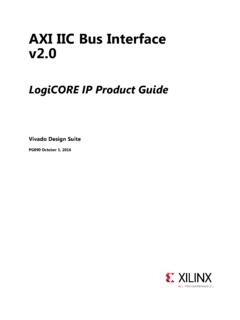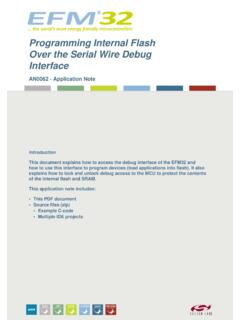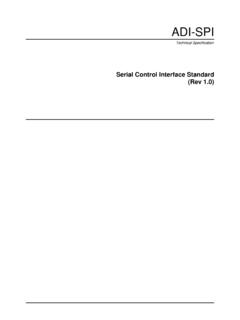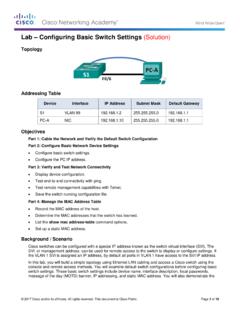Transcription of SPI (Serial Peripheral Interface) NAND Flash Memory
1 SPI(x1/x2/x4) NAND Flash GD5F4GQ4 UAYIG 1 SPI ( serial Peripheral interface ) NAND Flash Memory FEATURE 4G-bit serial NAND Flash Program/Erase/Read Speed -512M-byte -Page Program time: 400us typical -2048 bytes page for read and program, spare 64bytes -Block Erase time: 3ms typical -(128K + 4K)bytes per block for erase -Page read time: 120us maximum(w/I ECC) Standard, Dual, Quad SPI Low Power Consumption -Standard SPI: SCLK, CS#, SI, SO, WP#, HOLD# -40mA maximum active current -Dual SPI: SCLK, CS#, SIO0, SIO1, WP#, HOLD# -70uA maximum standby current -Quad SPI: SCLK, CS#, SIO0, SIO1, SIO2, SIO3 High Speed Clock Frequency Enhanced access performance -108 MHz for fast read with 30PF load -2kbyte cache for fast random read -Quad I/O Data transfer up to 432 Mbits/s -Cache read and cache program -2112/2048/64/16 wrap read option Software/Hardware Write Protection Advanced Feature for NAND -Write protect all/portion of Memory via software -Internal ECC option, per 512bytes -Enable/Disable protection with WP# Pin -Internal data move by page with ECC -Top or Bottom, Block selection combination -Promised golden block0 Advanced security Features -8K-Byte OTP Region Single Power Supply Voltage -Full voltage ~ Note.
2 Please contact GigaDevice for details SPI(x1/x2/x4) NAND Flash GD5F4GQ4 UAYIG 2 GENERAL DESCRIPTION SPI ( serial Peripheral interface ) NAND Flash provides an ultra cost-effective while high density non-volatile Memory storage solution for embedded systems, based on an industry-standard NAND Flash Memory core. It is an attractive alternative to SPI-NOR and standard parallel NAND Flash , with advanced features: Total pin count is 8, including VCC and GND Density range from 256 Mbit to 8 Gbit Superior write performance and cost per bit over SPI-NOR Significant low cost than parallel NAND This low-pin-count NAND Flash Memory follows the industry-standard serial Peripheral interface , and always remains the same pinout from one density to another.
3 The command sets resemble common SPI-NOR command sets, modified to handle NAND specific functions and added new features. GigaDevice SPI NAND is an easy-to-integrate NAND Flash Memory , with specified designed features to ease host management: User-selectable internal ECC. ECC code is generated internally during a page program operation. When a page is read to the cache register, the ECC code is detect and correct the errors when necessary. The 64-bytes spare area is available even when internal ECC enabled. The device outputs corrected data and returns an ECC error status. Assistant Block Management. With corresponding options set, the device can prohibit the Bad Block from being erased. This option features favor the block management convenience and enhance the performance. Internal data move or copy back with internal ECC. The device can be easily refreshed and manage garbage collection task, without need of shift in and out of data.
4 Power on Read with internal ECC. The device will automatically read first page of fist block to cache after power on, then host can directly read data from cache for easy boot. Also the data is promised correctly by internal ECC. It is programmed and read in page-based operations, and erased in block-based operations. Data is transferred to or from the NAND Flash Memory array, page by page, to a data register and a cache register. The cache register is closest to I/O control circuits and acts as a data buffer for the I/O data; the data register is closest to the Memory array and acts as a data buffer for the NAND Flash Memory array operation. The cache register functions as the buffer Memory to enable page and random data READ/WRITE and copy back operations. These devices also use a SPI status register that reports the status of device operation. CONNECTION DIAGRAM CS#SOWP#VSSTop ViewVCCHOLD#SCLKSI8 LEAD WSON12345678 SPI(x1/x2/x4)
5 NAND Flash GD5F4GQ4 UAYIG 3 PIN DESCRIPTION Pin Name I/O Description CS# I Chip Select input, active low SO/SIO1 I/O serial Data Output / serial Data Input Output 1 WP#/SIO2 I/O Write Protect, active low / serial Data Input Output 2 VSS Ground Ground SI/SIO0 I/O serial Data Input / serial Data Input Output 0 SCLK I serial Clock input HOLD#/SIO3 I/O Hold input, active low / serial Data Input Output3 VCC Supply Power Supply BLOCK DIAGRAM serial NAND controlerCache memoryNAND Memory coreECC and status registerVccVssSCLKSI/SIO0SO/SIO1CS#HOLD# /SIO3WP#/SIO2 ARRAY ORGANIZATION Each device has Each block has Each page has 512M+16M 128K+4K 2K+64 bytes 4096 x 64 64 - pages 4096 - - blocks SPI(x1/x2/x4) NAND Flash GD5F4GQ4 UAYIG 4 Figure1.
6 Array Organization 2048642048641 block1 block = (2K + 64) bytes x 64 pages = (128K + 4K) bytes1 page = (2K + 64 bytes)1 device= (128K + 4K) bytes x 4096 blocks = 4 GbCache RegisterData Register4096 Blocksper deviceSOSI Memory MAPPING 012409501630122111 BlocksRA<17:6>PagesRA<5:0 >BytesCA<11:0> Note: 1. CA: Column Address. The 12-bit address is capable of addressing from 0 to 4095 bytes; however, only bytes 0 through 2111 are valid. Bytes 2112 through 4095 of each page are out of bounds, do not exist in the device, and cannot be addressed. 2. RA: Row Address. RA<5:0> selects a page inside a block, and RA<17:6> selects a block. SPI(x1/x2/x4) NAND Flash GD5F4GQ4 UAYIG 5 DEVICE OPERATION SPI Modes SPI NAND supports two SPI modes: CPOL = 0, CPHA = 0 (Mode 0) CPOL = 1, CPHA = 1 (Mode 3) Input data is latched on the rising edge of SCLK and data shifts out on the falling edge of SCLK for both modes.
7 All timing diagrams shown in this data sheet are mode 0. See figure2 for more details. Figure2. SPI Modes Sequence Diagram CS#SCLKSCLKSISOCPOLCPHA0011 MSBLSBMSBLSB Note: While CS# is HIGH, keep SCLK at VCC or GND (determined by mode 0 or mode 3). Do not toggle SCLK until CS# is driven L O W. Standard SPI SPI NAND Flash features a standard serial Peripheral interface on 4 signals bus: serial Clock (SCLK), Chip Select (CS#), serial Data Input (SI) and serial Data Output (SO). Dual SPI SPI NAND Flash supports Dual SPI operation when using the x2 and dual IO commands. These commands allow data to be transferred to or from the device at two times the rate of the standard SPI. When using the Dual SPI command the SI and SO pins become bidirectional I/O pins: SIO0 and SIO1. Quad SPI SPI NAND Flash supports Quad SPI operation when using the x4 and Quad IO commands. These commands allow data to be transferred to or from the device at four times the rate of the standard SPI.
8 When using the Quad SPI command the SI and SO pins become bidirectional I/O pins: SIO0 and SIO1, and WP# and HOLD# pins become SIO2 and SIO3. HOLD Mode The HOLD# signal goes low to stop any serial communications with the device, but doesn t stop the operation of write status register, programming, or erasing in progress. The operation of HOLD, need CS# keep low, and starts on falling edge of the HOLD# signal, with SCLK signal being low (if SCLK is not being low, HOLD operation will not start until SCLK being low). The HOLD condition ends on rising edge of HOLD# signal with SCLK being low (If SCLK is not being low, HOLD operation will not end until SCLK being low). The SO is high impedance, both SI and SCLK don t care during the HOLD operation, if CS# drives high during HOLD operation, it will reset the internal logic of the device. To re-start communication with chip, the HOLD# must be at high and then CS# must be at low.
9 SPI(x1/x2/x4) NAND Flash GD5F4GQ4 UAYIG 6 Figure3. Hold Condition HOLDHOLDCS#SCLKHOLD# Write Protection SPI NAND provides Hardware Protection Mode besides the Software Mode. Write Protect (WP#) prevents the block lock bits (BP0, BP1, BP2 and INV, CMP) from being overwritten. If the BRWD bit is set to 1 and WP# is LOW, the block protect bits cannot be altered. SPI(x1/x2/x4) NAND Flash GD5F4GQ4 UAYIG 7 COMMANDS DESCRIPTION Table1. Commands Set Command Name Byte 1 Byte 2 Byte 3 Byte 4 Byte 5 Byte N Write Enable 06H Write Disable 04H Get Features 0FH A7-A0 (D7-D0) Wrap Set Feature 1FH A7-A0 (D7-D0) dummy(1) Page Read (to cache) 13H A23-A16 A15-A8 A7-A0 Read From Cache 03H/0BH A15-A8(4) A7-A0 dummy(2) (D7-D0) Wrap Read From Cache x 2 3BH A15-A8(4) A7-A0 dummy(2) (D7-D0)x2 Wrap Read From Cache x 4 6BH A15-A8(4) A7-A0 dummy(2) (D7-D0)x4 Wrap Read From Cache Dual IO BBH A15-A0(4) dummy(3) (D7-D0)x2 Wrap Read From Cache Quad IO EBH A15-A0(5) (D7-D0)x4 Wrap Read ID(8) 9FH A7-A0 MID DID Wrap Program Load 02H A15-A8(6) A7-A0 (D7-D0) Next byte Byte N Program Load x4 32H A15-A8(6) A7-A0 (D7-D0)x4 Next byte Byte N Program Execute 10H A23-A16 A15-A8 A7-A0 Program Load Random Data 84H(10) A15-A8(6) A7-A0 (D7-D0) Next byte Byte N Program Load Random Data x4 C4H/34H(10) A15-A8(6) A7-A0 (D7-D0)
10 X4 Next byte Byte N Program Load Random Data Quad IO 72H A15-A0(7) (D7-D0)x4 Next byte Byte N Block Erase(128K) D8H A23-A16 A15-A8 A7-A0 Reset(9) FFH Notes: 1. The dummy byte can be inputted or not. 2. The x8 clock = dummy<7:0>. 3. The x8 clock = dummy<7:0>, D7-D0. 4. The x8 clock = wrap<3:0>, A11-A8 or wrap<3:0>, A11-A0. 5. The x8 clock = wrap<3:0>, A11-A0, dummy<7:0>, D7-D0. 6. The x8 clock = dummy<3:0>, A<11:8>. 7. The x8 clock = dummy<3:0>, A<11:0>, D7-D0, D7-D0. 8. MID is Manufacture ID (C8h for GigaDevice), DID is Device ID (f4h for current device). When A7-A0 is 00h, read MID and DID. 9. Reset command: During busy, Reset will reset PAGE READ/PROGRAM/ERASE operation. During idle, Reset will reset status register bits P_FAIL/E_FAIL/ECCS bits. 10. Those commands are only available in Internal Data Move operation. SPI(x1/x2/x4) NAND Flash GD5F4GQ4 UAYIG 8 WRITE OPERATIONS Write Enable (WREN) (06H) The Write Enable (WREN) command is for setting the Write Enable Latch (WEL) bit.









